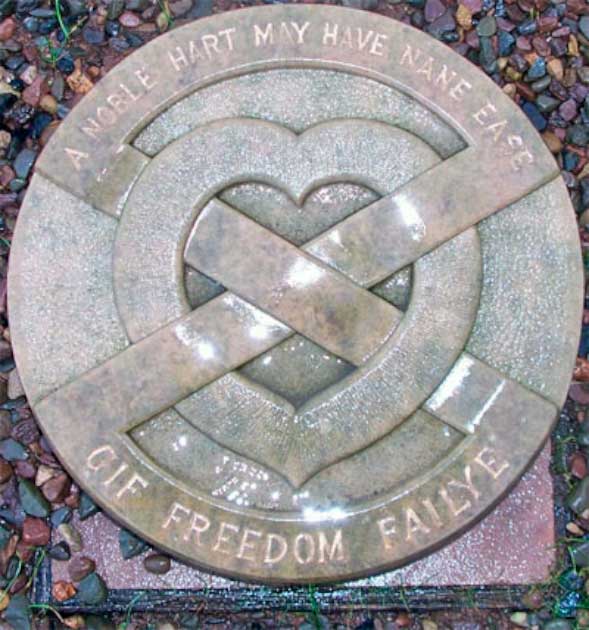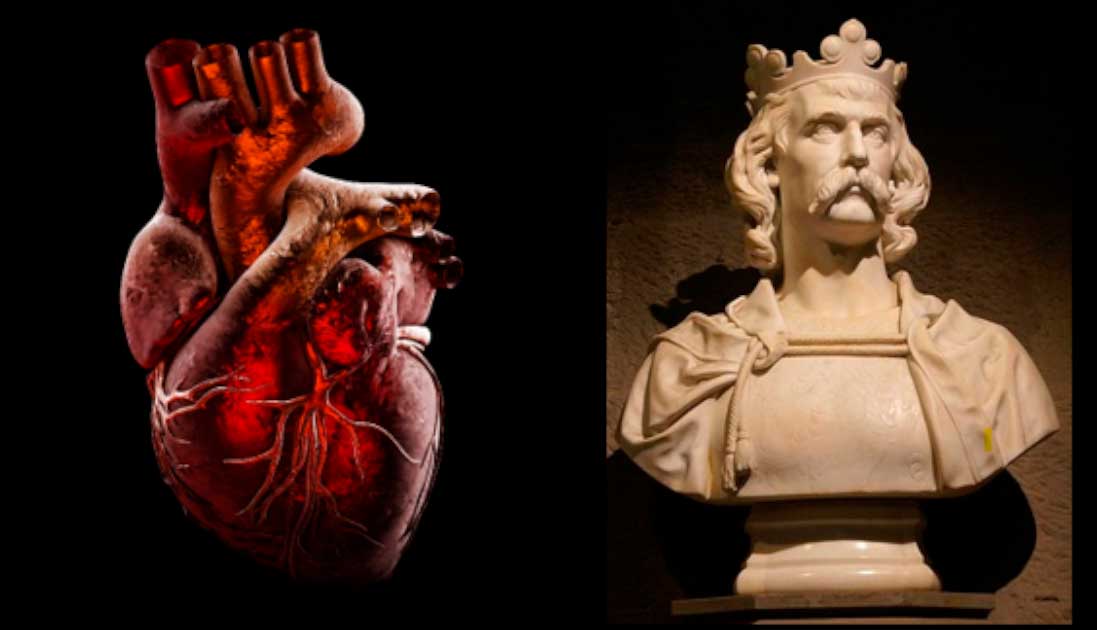The Long Road Taken By Robert the Bruce’s Heart
Robert the Bruce is one of the most, if not the most famous Scotsmen to have ever lived. Infamous for the 14th-century reign that saw him taking on England’s much bigger and better-equipped army and beating them! There probably wouldn’t be a Scotland today without him. However, as famous as he is, very few people are familiar with the gruesome fact that he had his heart shipped half away around the world. Or how even stranger still, it was lost for centuries. And the tales of Robert the Bruce’s heart are legend!
Robert the Bruce’s heart? But Who Was Robert the Bruce?
Robert the Bruce is seen as a national hero and legend within Scotland. He was born in 1274 AD and passed in 1329, and was King of Scots from 1306 to 1329.
As any Scot will tell you, Scotland has a long and storied history of wanting independence. The first war of Scottish independence raged from 1296 until 1328.
- Ireland’s Franciscan Friars: Men in the Middle of a Divided Society
- Battle of Bannockburn: A Scottish Hero Lights the Flame of Freedom
Robert the Bruce is remembered as being a fearsome warrior, great military strategist, and all-round legend. During his reign, he repeatedly beat back the English armies. A series of notable wins between 1310 and 1314 handed him control of most of Scotland.
By 1320, the Scottish nobility had written to the Pope declaring Robert their King. In 1324, the Pope declared Robert the King of an independent Scotland.
The English then proceeded to ignore the Pope’s declaration until 1328 when peace was finally declared between the two sides with the Treaty of Edinburgh-Northampton. In a nutshell, Robert the Bruce gave the English enough of a beating that he lived to finally see an independent Scotland.

While it’s clear that Bruce was crowned King of Scots, as per this modern tableau at Edinburgh Castle, what was unclear for a long time was the location of Robert the Bruce’s heart. (Kim Traynor / CC BY-SA 3.0)
How Did Robert the Bruce Die?
No one really knows how Robert the Bruce died. The prevalent theory for many years was that he died of leprosy. Anyone familiar with leprosy will confirm that as far as diseases go, it’s pretty unpleasant. Modern historians tend to agree it is unlikely Robert actually died from the disease, or indeed ever had it.
It’s difficult to imagine Robert doing very well on the battlefield or doing very well in kingly diplomacy with pieces of him rotting away and dropping off. Scientific analysis of a casting of Robert the Bruce’s skull and foot bone showed no evidence of leprosy. Instead, it is thought that maybe the leprosy rumor was used to perhaps harm his legacy.
- Ancient Scots Were Sometimes Born Apart But Buried Together
- Face of King Robert The Bruce, Outlaw King is Brought Back to Life 700 Years After His Death
It is much more likely he died from either a poor diet, stroke, or a heart attack. After all, life expectancy in the 14th century wasn’t exactly high. Lower still for a man who had spent much of his life on the battlefield.
What Happened to Robert the Bruce’s Heart?
Even though no one knows how he died, the most interesting thing about Robert’s death is what they did with his body. Robert died on 7th June 1329 at the Manor of Cardcross in Scotland. His loyal subjects wasted no time in chopping him up. He was eviscerated and his viscera (innards) were buried in the Chapel of Saint Serf, close to where he lived and died. His body was then embalmed and given a grand burial at Dunfermline Abbey. The funeral procession was long and escorted by several knights sporting black gowns. It was a truly regal event.
The evisceration may sound gruesome, but it was actually a normal thing to do with kingly remains at the time.
Robert was a deeply pious Catholic and he had always hoped to join the crusades. However, since he spent most of his life battling for Scottish freedom against the English he had never had the chance to go the Holy Land.
And this is where we come to Robert the Bruce’s heart. His final wish was for his heart to be extracted and taken on a holy crusade to battle God’s enemies. Sir James Douglas, Robert’s most loyal knight did just that. Robert’s heart was placed in a silver casket and hung around his loyal knight’s neck.
The problem? Crusades weren’t really in vogue anymore. Luckily for Douglas there was a war in Spain going on against the Moors. Given the circumstances Douglas didn’t really have a choice, and Islamic enemies were enemies of Bruce’s god no matter where they were.
Sir Douglas traveled to Spain and was given command of a good chunk of the Spanish forces. Douglas fought bravely against the Moors but was ultimately slain in battle, still carrying Bruce’s heart around his neck.
Some accounts have Douglas running into the melee and launching Bruce’s heart at the Moors before yelling something awesome along the lines of, “Go first as thou hast always done” or “Lead on brave heart, I’ll follow thee.”
Unfortunately, it sounds like these accounts are more than a little unreliable. And in fact they are.
In fact, upon his death, Douglas’s remains, complete with Bruce's heart, were shipped back to Scotland.

Modern marker for the site of the burial of the heart of Robert the Bruce at Melrose Abbey in Roxburghshire, Scotland, which was finally confirmed in 1996. (Otter / CC BY-SA 3.0)
Losing a Heroic Heart? But Robert the Bruce’s Heart Beats On
Bruce’s heart was returned to Scotland by Sir William Keith. Upon arrival, the heart was buried at Melrose Abbey in Roxburghshire, Scotland. Bruce had requested this location as it was a place he considered close to his heart (no pun intended). The exact location of the heart was never properly recorded and so the heart was considered lost to time.
That was until the summer of 1996. A team from Historic Scotland was carrying out excavations on the floor of the Chapter House at Melrose Abbey when they unearthed a lead container under the floor.
- Did Scandinavian Vikings Carry Leprosy To Ireland?
- 1500-Year-Old Skeleton of Scandinavian Man Might Be Patient Zero in Spread of Leprosy to Britain
A small hole was drilled into the container and using a fiber-optic cable the team took a look inside. There they found another lead container. Inscribed upon it was, “The enclosed leaden casket containing a heart was found beneath Chapter House floor, March 1921, by His Majesty's Office of Work.”
Amazingly Robert the Bruce’s heart had been rediscovered way back in 1921 but for whatever reason, no one at the time had bothered to investigate it further or even mark its location. Happily, on 22nd June 1998, Bruce’s heart finally met its final resting place. The heart was reburied at Melrose Abbey in a private ceremony.
One final mystery remains. Is the heart now buried at the Abbey truly Robert the Bruce’s heart?
Historic Scotland refused to do tests on the heart. It was deemed that the original owner of the heart doesn’t really matter. It’s the symbolism that matters.
As Donald Dewar, Secretary of State for Scotland, put it at the time, "There is a strong and proper presumption that this is the heart, but in a sense, it does not matter. The casket and the heart are symbols of the man."
And let’s be honest, how many metal containers filled with historic hearts is any abbey likely to have hidden away? It surely must be Robert the Bruce’s heart!
Top image: Robert the Bruce’s heart was found in 1921 and lost again until 1996. Now this King of Scots (Bust of Robert the Bruce at the National Wallace Monument) rests in peace, knowing his final wishes were granted. Source: Left: tussik / Adobe Stock; Right: Otter / CC BY-SA 3.0
References
English Monarchs. n.d. Robert The Bruce. Available at: https://www.englishmonarchs.co.uk/bruce_16.html
Johncock, J. n.d. Melrose Abbey and Robert the Bruce’s Heart. Available at: https://hiddenscotland.co/melrose-abbey/
Manning, S. 2016. The Heart Of Robert the Bruce. Historian on the Warpath. Available at: https://scottmanning.com/content/the-heart-of-robert-the-bruce/
Ross, D. 1999. On the Trail of Robert the Bruce. Glasgow.




















Comments
This is such a fantastic tale, that it must be true. Only from the independent Scotsman lore, could this originate.